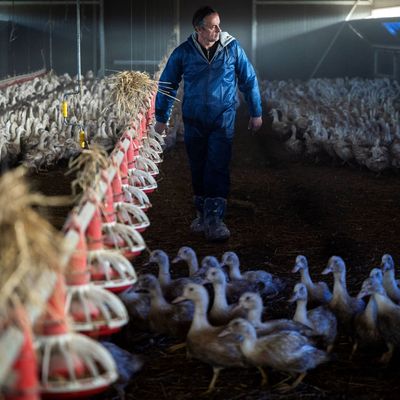
Almost three years after COVID-19 rolled across America, the virus has never felt like less of a daily menace. But don’t worry: The possibility of another global pandemic is never very far off. Avian flu, specifically the H5N1 strain, has spread widely among bird populations and other animals in the last couple years. More concerning for humans, it tore through a Spanish mink farm in October — a disquieting event not only because the virus doesn’t usually spread among mammals, but because minks, who have upper-respiratory tracts similar to humans, are often susceptible to the same kinds of viruses as us. No people were infected during the great mink outbreak of ’22, but the episode has made many virologists even more nervous than usual. So is avian flu really the next global menace? I spoke with Katelyn Jetelina, an epidemiologist and data scientist who gained a significant following with her Twitter account and newsletter during COVID, about the current risk and why another pandemic soon is inevitable.
Should we start panicking now, or wait a couple weeks?
Who is “we” in your question? Us epidemiologists — we’ve always been nervous about H5N1. And I would say that many of us continue to put money on the flu causing a major pandemic. So “we” being public-health officials, I think we need to work toward improving our surveillance around it, thinking through what we need to do with our vaccine supply. We’re really in the preparation phase.
I guess my question was on behalf of your average anxious New York reader.
I do not think we’re at a phase where the public needs to be worried, because there’s no action connected to that worry. Typically, with really effective crisis communication, we recommend an action for the public, and right now the action is just to be aware. My hope is that if the public-health world can prepare, then public health will work. And when it works, it’s largely invisible to the public.
In a Times op-ed last week, Zeynep Tufekci wrote that the bird flu has a 56 percent mortality rate among humans. You challenged those numbers a bit in a Twitter thread. Can you explain why the actual rate might be scary, but not a Station Eleven type of scenario? Or The Last of Us — pick your postapocalyptic show.
I actually really enjoyed that piece, and I want to be clear — she didn’t lie. It is a 56 percent mortality rate. But that 56 percent is likely ascertainment bias. Who gets tested and where are people getting tested for H5N1? And we don’t know who doesn’t get tested, people who would also be probably surviving. The other thing is that one of the reasons avian flu is so lethal, and you mentioned this with the mink-to-mink transmission, is that it’s tied to being poorly transmissible from the lower respiratory tract. If it mutates to become more transmissible, i.e., in the upper respiratory tract, the lethality will likely decrease. And we saw lower lethality in that outbreak in Spain, about 4 percent. So I think we just really need to be careful about how we talk about that 56 percent, and not necessarily lead with fear. If this thing does jump to humans, the nuance of scientific communication is very important.
To what extent do we even know what would happen if humans contract this flu? How much can you draw inferences from the animal population at all?
It’s nearly impossible. The truth is, we have no idea what the case fatality rate for humans will be, firstly because it hasn’t made that viral-evolution jump yet. And that jump can change a lot of things. But I think the bottom line, and I said this in my Twitter thread — is even if the mortality is the same as our current influenza strains, it would be devastating because we’d have this additive effect of respiratory viruses. Even if it’s the same as our seasonal influenza, that’s quite terrifying actually because our hospital systems are just hanging by a thread during these winters already.
What would it look like to get appropriately ready for a bird-flu spillover into humans? Tufekci had a laundry list of recommendations, including bolstering the existing vaccines we have for H5N1 and prioritizing getting mRNA vaccines up and running, among other things. Do you largely agree with the prescriptions she laid out?
I have a little different perspective, just because I’m an epidemiologist, and my biggest focus is around data infrastructure. So figuring out a way to strengthen our fragmented public-health system in terms of data in particular. And then of course, just given my role in the past three years, the scientific communication aspect of this — who does the communicating, how we frame it if there’s another threat, how we anticipate the new information ecosystem — all of that. We constantly go through the cycle in public health of panic and neglect, panic and neglect, and we need to get out of that. Given where we’re headed with climate change and new viruses and the speed in which novel viruses are a threat to us, it’s not a sustainable model. So I think that would be the lowest-hanging fruit through investment.
Though at the beginning of COVID, it was the opposite problem — many experts were saying it wasn’t much of a problem, and then were quickly overwhelmed with the reality on the ground.
Yeah. And so this is a really tough balance, right? That’s why communicating the nuance is going to be super important. I truly think one of the reasons the United States did so poorly with COVID-19 is because of front-end framing of it: not explaining the real threat, not framing it in the correct way. And it ultimately hurt us in the long run.
These viruses are spreading around more quickly than they used to. What do you feel is causing that for the most part? Is it globalization primarily? Climate change? Or a confluence of all these factors of the world becoming increasingly interconnected?
Since the Spanish flu, we’ve seen the emergence of diseases come faster and faster. And this is due to myriad factors, but there are two main things driving it. One is that diseases are jumping from animals to humans because of climate change — people are moving into areas that have never been inhabited before. But also, animals like mosquitoes are geographically shifting. And then, yeah, humans easily spread the virus due to globalization. Humans are able to travel more than ever, and so viruses will just be introduced into places that they’ve never been before. So there’s no question we’re going to have another pandemic in the coming years. I think the biggest question is how much we do to prepare.
This interview has been edited for length and clarity.






























